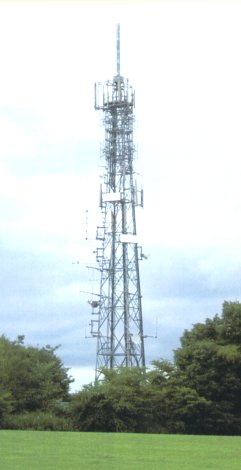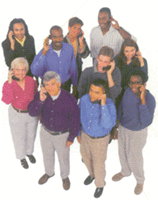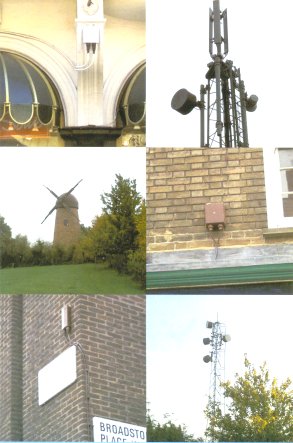Originally published in February 2003 icon

Mobile phone companies say there is no proof that phone masts are a health risk, and until now, the government has concurred, although at last they have announced an official investigation.
The Lowdown on a Tall Story
In January 2002 a small village in Spain won a rare but potentially powerful victory. It left a bitter taste, for the parents of Valladolid were fighting, they felt, for their children’s health which should never have been put at risk.
These parents sought and secured - a court order for the removal of 36 mobile phone transmitters installed on a building 50 metres from their local primary school.
In the 18 months since these masts went up three children aged 5-10 developed leukaemia and a fourth had Hodgkin’s Disease. And before the masts, there hadn’t been a single childhood cancer in the village for 32 years. So were the mobile phone masts to blame? Absolutely not said government adviser Juan Represa, "If the antennas were the cause then, taking into account the number across Spain, we would have hundreds of thousands of cases of cancer". Luis Martin, a parent and doctor disagreed: "We don’t believe this is a coincidence. The antennas were placed so close to the playground that the children have been affected by radio magnetic waves".
Spain is far away enough for us to feel compassion with this case tempered by some detachment. In fact their local controversy is a classic reflection of the health controversy now accelerating not only in the UK but also internationally. Our National Radiological Protection Board insists that radiation levels surrounding mobile phone masts are tiny, just 0.02 per cent of official safety levels. But the UK also has its cancer clusters around mobile masts, 14 known so far, among them those in Crediton, Devon; Carnarvon Road, East London; Gainsborough, Lincs; Norwich, Norfolk; Tolworth, Surrey and Wishaw, a very small West Midlands village. Hence the mounting concern from a growing number of doctors and scientists, like engineer and physicist Alasdair Philips of Powerwatch.
 The UK also has its cancer clusters around mobile masts
The UK also has its cancer clusters around mobile masts
"The pro-mast argument rests on radiated power from cell phone base stations" be says, "which is usually lower than that from radio or TV transmitters. Basically it’s a case of "if it doesn’t heat you it doesn’t hurt you. Unless you’re in a microwave oven situation you are perfectly safe." But TV and radio transmitters don’t pulse in the same way as mobile masts and it’s this microwave pulsing that’s the problem. Existing guidelines are not intended to protect against long term chronic effects such as cancer and stress due to sleep disruption. Professor Henry Lai, of Washington University, says that these microwave pulses are chronic invisible stressors that have the same adverse effects on the body as being continuously exposed to loud noise. Dr Jerry Phillips, a research chemist from Colorado, links mast microwave exposure with DNA damage, also stressing that the brain is "exquisitely sensitive" to radio frequency radiation. And Dr Gerard Hyland of Warwick University is not alone in his particular concern about the risk to children, who have weaker immune systems, developing nervous systems and thinner skulls. "No radiation is good for you." says Dr Ian Gibson, a biological scientist who is also the Labour MP for North Norwich: "It is a question of where the so-called safe level line falls."
icon is committed to helping readers live well, not worry more. We all know that everyone today - whether touched by cancer or not - is already at risk of Scare Fatigue as one health concern after another storms the news. We are, however, bringing the mobile mast debate to your attention because what we - that’s ordinary people, the phone companies and government - do next is likely to affect the well being of several generations to come. And because there are positive steps that you might want to take to minimise the risks from mast emissions The first is reviewing your mobile phone usage

More Phones Mean More Masts
The upshot of our rising mobile demands is that the 30,000 existing UK masts are set to rise to 50000 by the end of this year Signal strength from these masts has to be increased because we not only use our mobiles from outdoors, but from cars and trains and offices - so the signals have to penetrate building and vehicle materials. All this is great - at the moment - for the 5b telecom industry and for government. But is profit being put before people’s health? Alasdair Philips cites the total mobile networks’ spending on safety research as less than one hundredth of one per cent of their expenditure. Pulsed microwaves, he points out, are not necessary and there are more sophisticated ways of allowing users to share call channels that do not use the system (Time Division Multiplex Access) that causes pulsing.
Hide and Seek
As many a local planning department will attest, nobody wants more tall "eyesore" masts despoiling town and country scapes even though, health-wise, these are normally far the safest. Faced with this NIMBYism, phone companies have set about the stealth option - reducing mast size so that they can be inset invisibly on building walls - and (because enough of us are already campaigning about the health risks) disguising them as flagpoles, tucking them into burglar alarm boxes and chimney stacks, even biding them in garage forecourt although we are told to switch our mobile phones off! Such is the demand for mast premises that underground reporters from the Sunday Telegraph (Nov 2002) found four out of five mobile companies prepared to put up a concealed mast on a private house and pay as much as 7000 a year in rent". To impoverished church congregations, mast rental money is as good as manna from heaven: "Worship God not Orange" was one concerned mother’s ’cri de campaign" when she discovered her local Harrogate church had installed a mast disguised as a flagpole.
The Science Behind The Turore
 It will take 20 or 30 years before we can really assess the ’cause and effect" health equation of mast multiplication
It will take 20 or 30 years before we can really assess the ’cause and effect" health equation of mast multiplication
The complacent might say that worrying about masts is loony fringe stuff. The complacent once said the same about tobacco and asbestos. It will take 20 or 30 years before we can really assess the ’cause and effect" health equation of mast multiplication. Meanwhile human beings are already functioning in an electromagnetic environment that has 10,000 times more radio frequency radiation than the one in which we evolved. Our bodies and the cells within them are themselves like antennas - extremely sensitive receivers and emitters of electromagnetic radiation. Scientists are not saying that masts cause cancer or that everyone is at equal risk of Harm. But the concern is that low-level microwaves can disrupt natural processes and undermine the body’s defence system. Many studies have shown that these low-level microwaves interfere with the production of melatonin which is thought to facilitate the deep level of sleep during which time the body rests and repairs itself.
Dr NeIl Cherry, a university specialist in Environmental Management from New Zealand, identifies 13 studies that find significant EMR-associated melatonin reduction in humans. Melatonin production is highest about one and half hours after falling asleep and is vital for deep and healthy sleep. It’s also a scavenger of free radicals and boosts the immune system - specifically F-helper, T-killer cells and natural killer cells that attack cancer cells. Dr Cherry has also identified 23 studies showing increased brain tumours in EMR-exposed people. SAS, the airline has researched melatonin disruption in long-haul aircrews; there has also been research amongst women night workers. Both groups have a Higher incidence of breast cancer.
But government and the mobile phone companies have until now maintained there is no conclusive proof that masts ert- a health risk. Accordingly, government guidance to councils is that health should not be considered when dealing with mast applications. However, the government has just ordered an official investigation so the advice may change.
 Government guidance to councils is that health should not be considered when dealing with mast applications
Government guidance to councils is that health should not be considered when dealing with mast applications
At present, planning authorities find themselves between a rock and a hard place - they are trapped between the residents they serve and the fear of hefty legal costs should a mast company appeal successfully against rejection. Campaigning group Mast Sanity argues that even without 100 per cent proof the Maastricht Treaty obliges governments to invoke a ’precautionary" principle and put a moratorium on mast network expansion. The UK interpretation of this precautionary principle has been worryingly watered down. In Germany, Switzerland, Scandinavia and Russia, the protocol is far more rigorous than our own.
More than 300 medical professionals from around the world have so far signed the Freiburger Appeal, launched in October 2002- a document that holds rnobiie masts (along with intensive mobile phone use and the new digital cordless land line phones) responsible for a whole gamut of conditions ranging from headaches, inner agitation, sleeplessness and chronic exhaustion through tinnitus, and susceptibility to infection, to heart attacks, Alzheimer’s, epilepsy, cancerous afflictions, leukaemia and brain tumours. Having seen "a dramatic rise in severe and chronic diseases among our patients" these Freiburger medics observe a "very serious development through which the health of many people is being threatened." Freiburger has been translated into 15 languages and will be taken to the European Parliament. Its signatories are basically saying, "We cannot wait. People are getting ill so we have to make a stand."
Cancer Clusters
The residents of cancer clusters, where an unusually high incidence of disease appears close to mast installations have no doubt that they are the victjms of consequence not chance. Tom Tate, a town councillor in Gainsborough has been trying to draw attention to this problem for two years. But no one, to his frustration, seems willing to listen. The NRPB say these clusters are only "anecdotal stories" unsupported by scientific evidence. Pro-masters also argue that such clusters are not unduly surprising as one in three people will now contract cancer at some point in life. But this comment begs the inexorable question why are the statistics soaring now? Headlines such as "Tumours, cancers and blackouts in a 20-mile radius" (Glasgow) and "Neighbours struck down in shadow of mobile mast" (Barnoldswick, Lancs) are starting to pepper the local and national press. A number of people in mast-heavy areas report that they can sense, if not actually hear a low-level hum all the time. Some say they start to feel better after just a few days away from home - or if the transmitters are for some reason switched off. And many people who are now ill lived in their homes for years without illness before the masts appeared.

Eileen O’Connor from Wishaw, who has a son of 12 and a daughter of 11, has just returned from a months family holiday celebrating what is hopefully the end of a year of hell. And the start of local activity to remove the mast she and five neighbours believe responsible for their cancers.
In 2002 Eileen was diagnosed with breast cancer, though there is no family history of this type her grandmother had stomach cancer, but at aged 80. Eileen has undergone three operations, including removal of 23 lymph glands and breast reconstruction- but was still suffering dizzy spells and sleep disturbance before her holiday. After 10 days away from home, her symptoms lifted.
The family is now planning to move away for five years - house hunting with the aid of an AcoustiCOM - in the hope that the Wishaw mast will go in the meantime.
"We may have been uncertain in the beginning, but with other women in our tiny community diagnosed with breast cancer around the same time, we are now convinced that the mast is responsible," says Eileen.
Sue Webster, a psychotherapist and nutritionist, is the first and only person to collect evidence from all the 14 UK clusters and visit homes with an AcousticOM instrument that translates pulsing EMRs into noise. "When I started out I expected the microwave power levels would be higher in places where there were a lot of cancers. I have visited hundreds of houses and found that this is not the case. It’s the pulsing that is far more intense in these houses. My first experience of violent pulsing was in three Gainsborough houses where four people had cancer. You could hardly hear yourself speak. These houses were directly opposite and about 100 metres from a mast which was installed seven years ago with six antennas and two microwave dishes." There are six other cases of cancer within 200 metres, including 10 year-old Ryan Petch who has non-Hodgkin’s Lymphoma and a 30 year old currently in remission from leukaemia.
On the outskirts of Crediton a mast was installed eight years ago. But before the beam hits the town it is intended to serve, it passes through four houses all in a line within 300 metres of the mast. In the first house Emma (ann, seven, has leukaemia, and in the others two more people also have leukaemia and another has stomach cancer.
In Carnarvon Road, part of Ian Duncan Smith’s East London constituency, five adults have developed cancer (three breast, one thyroid, one bowel cancer) in the past six years. Their houses are all in a line within 200 metres of a building which (at least until recent press exposure) had 16 masts on the roof. As with similar clusters, there are also intersecting mast fields nearby.
 Mobile phone companies continue to trot out bland, blanket sound bites about meeting official guidelines
Mobile phone companies continue to trot out bland, blanket sound bites about meeting official guidelines
In the latest ’hotspot’ to emerge this January - the hamlet of Cranholme Hill, Ballygawly Co. Tyrone, N. Ireland - there are only five houses, but six cancer sufferers.
Despite these known clusters, mobile phone companies continue to trot out bland, blanket sound bites about meeting official guidelines. There are however encouraging signs of chalbenge to the status quo. Here, in response to constituents’ growing concern, an all-parliamentary Mobile Group chaired by Phil Willis is probing the issue. In Sicily, September 2002 an international meeting of eminent doctors and environmental scientists drew up the Catania Resolution rejecting the argument that weak EMFs electromagnetic fields cannot interact with human tissue. They called for gaps in knowledge to be plugged. Residents of Bnai Brak in Israel have collectively insisted on permits certifying "acceptable levels of radiation emissions from every single communication installation" plus an assurance that no cell phone tower be constructed in any residential area. Back home again in Wishaw, where seven cancers have occurred amongst 15 residents living close to a mast put up eight years ago, a neighbours action group has taken legal action to "put on notice" to the mast owners that action may in the future be taken against them if a medical case is proven. The document - certain to put the wind up mobile mast-ers - cost little more than 100 in legal fees. The lessons of Valladolid are striking home.
What You Can Do
If you want to keep abreast of news and information on this issue, contact campaign group Mast Sanity (http://www.mastsanity.org).
Also see http://www.powerwatch.org.uk for breaking news and research.
Alasdair and Jean Philips’ book Mobile Phones and Masts - The Health Risks is available for 15 from Perspective Scientific (see below).
If you want to check the levels and/or the pulsing quality of RF and microwave radiation in your own home, you can buy a COM Environmental Microwave Monitor (to measure the levels in Volts/meter) for 149 plus vat, and/or an AcoustiCOM (to hear the pulsing) for 79 plus vat, or rent each for 28 plus vat per week from Perspective Scientific Ltd, 100 Baker Street, London W1U 6WB, Tel: 0207 486 6837.
For a 10% saving on all prices from Perspective Scientific. Please quote reference icon/NCLF when placing order.
You can check the number and location of mobile masts around your house on the government website http://www.sitefinder.ofcom.org.uk/. However, hidden installations may not be registered and the site finder information has often been found to be incorrect.
Even if it’s an option, moving house may be an excessively drastic reaction to the proximity of masts. If you do have real health concerns you can help protect your health without spending a fortune. As Sue Webster says "Once you know where the pulsing is strongest you can usually find a way of sleeping or spending most of your time out of it. It’s rare not to find a safe space, but if so, you can look at extra measures - protective glass windows, wallpaper (available next summer) and paint, and special mesh curtains."
For further information contact Perspective Scientific or expert adviser Simon Best (premium line 1.50 per minute 0906 401 0237).